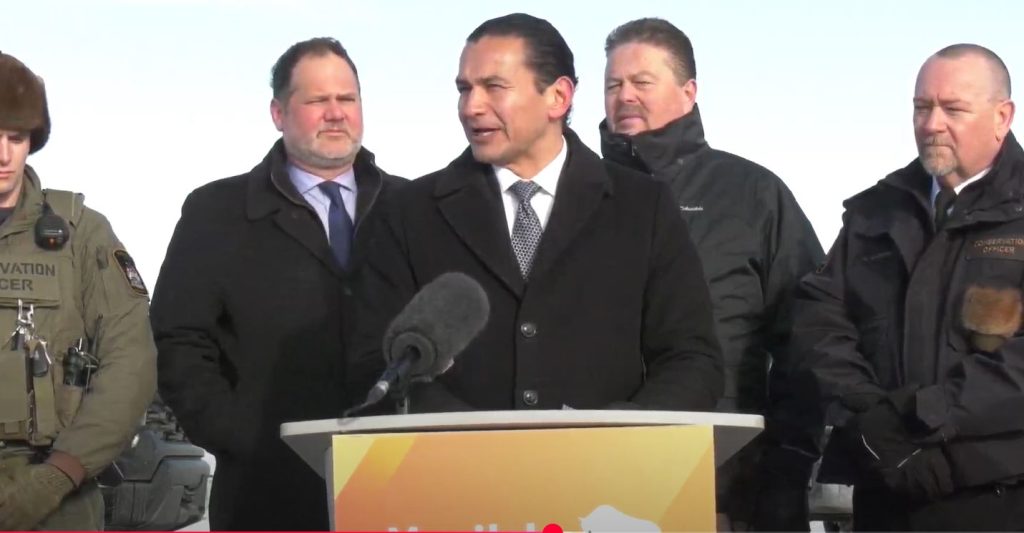Canada-U.S. refugee pact changes expected to ‘exacerbate existing threats’: memo

Posted October 21, 2023 7:53 am.
A newly released memo shows federal officials warned last spring that expanding a bilateral refugee pact to the entire Canada-U.S. border would likely fuel smuggling networks and encourage people to seek more dangerous, remote crossing routes.
Officials feared the development would also strain RCMP resources as irregular migrants dispersed more widely across the vast border.
The April memo, made public by Public Safety Canada through the Access to Information Act, was prepared in advance of a Cross-Border Crime Forum meeting with American representatives.
Under the Safe Third Country Agreement, implemented in 2004, Canada and the United States recognize each other as havens to seek protection.
The pact has long allowed either country to turn back a prospective refugee who showed up at a land port of entry along the Canada-U.S. border — unless eligible for an exemption — on the basis they must pursue their claim in the country where they first arrived.
However, until this year it did not apply to those who crossed between official entry points.
On March 24, during U.S. President Joe Biden’s visit to Ottawa, the two countries announced the Safe Third Country Agreement would cover the entire land border effective the following day.
The move followed concern and debate about increases in irregular migration to both Canada and the United States.
The internal memo said the Cross-Border Crime Forum was an opportunity to reaffirm Canada’s commitment to ensuring fair, orderly migration between the two countries, in part through support for expansion of the refugee agreement.
The memo noted there was a drop in the number of irregular border interceptions by the RCMP between March 25 and April 25.
But “Despite preliminary positive results related to irregular migration volumes, changes to the (Safe Third Country Agreement) are expected to change the criminal threat environment and exacerbate existing threats to the Canada-U.S. border,” it noted.
It said individuals may be motivated to cross the border via more dangerous and remote routes in order to avoid law enforcement and circumvent the expanded protocol.
It is “highly likely that human smuggling networks will expand their operations and play a vital role in these clandestine entries” by providing services such as safe houses, fraudulent documents and transportation to and from the border, the memo said
“Human smuggling creates significant risks for irregular migrants and exposes them to dangerous conditions. Irregular crossings in remote, rural, or isolated locations may result in physical injury or fatalities.”
In addition, the memo said, the RCMP is aware that irregular migrants may become victims of physical or sexual abuse or human trafficking during their passage to Canada.
Irregular migration through isolated regions puts responding RCMP members’ health and safety at risk, the memo added. “These activities also produce challenges on the RCMP’s resources as irregular migrants become less concentrated and more dispersed across the Canada-U.S. border.”
The memo also warned that organized crime groups might use shifting irregular migration routes along the border to smuggle illicit commodities including drugs, guns and tobacco.
The internal warnings echoed concerns the Canadian Council for Refugees voiced upon expansion of the Safe Third Country Agreement. In that sense, the content of the memo is not surprising, said Gauri Sreenivasan, a co-executive director at the council.
“What’s very concerning is it underscores how clearly the government was aware of the dangers that were associated with closing down the border,” she said in an interview.
The council has consistently argued against the refugee pact, saying the U.S. is not always a safe country for people fleeing persecution.
The best public policy is to allow a claimant to show up safely at a border crossing and to hear their case fairly, Sreenivasan said. “There is nothing illegal about asking for protection. In fact, it’s a right protected under international human rights law.”
In late March, just after expansion of the refugee agreement, eight people drowned in the St. Lawrence River when an apparent attempt to smuggle them into the U.S. went awry.
A statement issued following the Cross-Border Crime Forum meeting in late April said cabinet members from the two countries asked officials to review recent incidents along the border to identify opportunities to improve intelligence, detection and interdiction to disrupt cross-border smuggling, investigate events and hold people accountable.
RCMP spokeswoman Marie-Eve Breton says co-operative efforts “have demonstrated that we can respond to the evolving threat environment encountered at the border.”
When people crossing between ports of entry are intercepted by the RCMP or local police, they are brought to a designated port of entry providing there are no national security or criminality concerns identified, Breton said. Once at the port of entry, the Canada Border Services Agency will then determine whether or not the claim is eligible under the Safe Third Country Agreement.
The border service agency says it works closely with Canadian and U.S. partners to ensure the lawful, safe and humane treatment of refugee claimants while maintaining border security.
“It is illegal to enter between ports of entry and it is not safe,” said border agency spokesperson Maria Ladouceur. “We encourage asylum seekers to cross the border at designated ports of entry.”
Breton also urged border-crossers to follow the rules. “This process is safer, faster and according to the law.”








